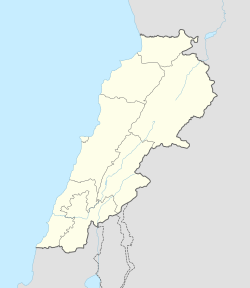Ain Ebel
|
Ain Ebel عين إبل |
|
|---|---|
| City | |
| Location within Lebanon | |
| Coordinates: 33°07′N 35°24′E / 33.117°N 35.400°ECoordinates: 33°07′N 35°24′E / 33.117°N 35.400°E | |
| Grid position | 187/279 PAL |
| Country |
|
| Governorate | Nabatieh Governorate |
| District | Bint Jbeil District |
| Highest elevation | 850 m (2,790 ft) |
| Lowest elevation | 750 m (2,460 ft) |
| Time zone | EET (UTC+2) |
| • Summer (DST) | EEST (UTC+3) |
| Dialing code | +961 |
Ain Ebel (Arabic: عين إبل) is a village located in the Caza of Bint Jbeil in the Nabatiye Governorate in Lebanon.
Historians as Anis Freiha and Fr Youakim Moubarak believe that the name of Ain-Ebel derives from two words,Ain and Ibl.The first means spring as many places in Lebanon are named,and the second word means irrigation. Combined in one (Ain Ebel) the two words mean the spring of irrigation. Usually "Ibl" is opposed to Baal, the greater God associated to his female divinity Astarte, or Diane, Goddess of fertility and hunting in the old Cananean religion.Palmer, in 1881, wrote that it meant "The spring of camels".
Ain Ebel is a historic village with numerous archaeological sites that date to Biblical times and before. A Heavy Neolithic site of the Qaraoun culture was discovered by Henri Fleisch west of Ain Ebel in the Wadi Koura, with tools found suggested to be part of a forest dweller's toolkit at the start of the Neolithic Revolution. On the outskirts of the village is an area called Chalaboune where Ernest Renan, a French historian and philosopher who was sent by Emperor Napoleon III to Lebanon, found ancient graves. On one of the graves, Renan discovered a bas-relief of Apollo and Artemis. The relief was transported to France where it remains today at the Louvre. In 2011 and after months of negotiation, the Musée du Louvre agreed to make an exact replica of the bas-relief, which was delivered to the municipality of Ain Ebel in November.
...
Wikipedia

